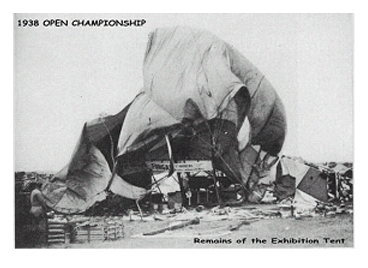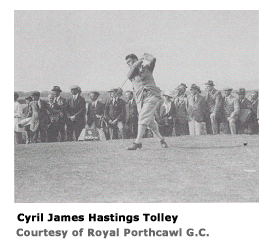|
| |
The 1938 Open had been scheduled for Deal, but was switched to Royal
St. George’s after the sea inundation of the Royal Cinque Ports
course during a storm and a subsequent drought caused considerable
damage. The weather in the late thirties seemed to foreshadow the
gathering gloom in Europe and it was to throw everything it had at
Sandwich on the final day. It was not a Ryder Cup year and the
Americans stayed away leaving the field open for another British
triumph, although the South African Bobby Locke, who had now turned
professional, was beginning to show signs of things to come. He had
shot a 69 in the qualifying rounds and qualified in third place
alongside L.G.Crawley; two shots behind the leading qualifier Johnny
Fallon and one behind Henry Cotton. I joined them in the
championship proper and was only a shot out of the lead, as the
final day dawned. In the lead on 140 were Dick Burton, Jack Busson
and Bill Cox with Jimmy Adams and me on 141 then Reg Whitcombe on
142. Alf Padgham was on 146 and Henry Cotton made the cut with one
to spare on 147. The first two days had been calm and sunny but the scene that
greeted us on arrival at the course was one of devastation. The
massive eight masted exhibition tent, then run by Golf Monthly, had
been torn to shreds overnight by a violent gale. Twisted metal lay
everywhere and the contents were strewn all over the course. The
masts of the tent, the largest ever at the championship, stayed up
for a long time with remnants of canvas flapping from them. Henry
Longhurst said “it looked like a great eight-masted schooner in full
sail”. The gale continued during the final thirty-six holes played
on the Friday with wind speeds of 50 to 70 mph reported, gusting to
80 mph at times. “The wind was the strongest I have personally ever
known in a championship”, wrote Longhurst. It was much worse than
the Saturday at Muirfield in 2002 with players being blown clean off
their feet, although we did not have the rain to contend with. Some
players were taking three full drivers to reach par-4s and four,
five and even six putts were taken, although some benefited when
their ball was blown into the hole. Johnny Fallon played three shots
out of a greenside bunker and each time the ball was blown back to
his feet. The first two days had been calm and sunny but the scene that
greeted us on arrival at the course was one of devastation. The
massive eight masted exhibition tent, then run by Golf Monthly, had
been torn to shreds overnight by a violent gale. Twisted metal lay
everywhere and the contents were strewn all over the course. The
masts of the tent, the largest ever at the championship, stayed up
for a long time with remnants of canvas flapping from them. Henry
Longhurst said “it looked like a great eight-masted schooner in full
sail”. The gale continued during the final thirty-six holes played
on the Friday with wind speeds of 50 to 70 mph reported, gusting to
80 mph at times. “The wind was the strongest I have personally ever
known in a championship”, wrote Longhurst. It was much worse than
the Saturday at Muirfield in 2002 with players being blown clean off
their feet, although we did not have the rain to contend with. Some
players were taking three full drivers to reach par-4s and four,
five and even six putts were taken, although some benefited when
their ball was blown into the hole. Johnny Fallon played three shots
out of a greenside bunker and each time the ball was blown back to
his feet. I was drawn with defending champion Henry Cotton, then at his peak and large crowds followed us around the course. In those days they stood right around the edge of the greens, which was an advantage in those conditions as you had some shelter from the wind when putting. Henry’s accuracy was renowned but few today realise just how long he was from the tee. He was capable of 300-yard drives when he turned on the power – by no means common back then. Cotton was an ‘aloof’ character, very intense when on the golf course and he seldom spoke (Walter Hagen called him “Concentration Henry”), but his golf did the talking and for the first twelve holes of the final round his play was majestic. He was always a good wind player and that day he was at his best. At the 370-yard dogleg second hole he drove downwind across the sand-hills onto the green and holed for an eagle two. At the 11th, then a 384-yard par-4, he drove the green again and two-putted for his birdie. He covered the front nine in 35 and started back four, three, three. It was the best wind golf I have ever seen. There were no leader boards  then but we knew he was close
to the lead; then three putts on the 13th cost him a five and shots
started to go. The famous 520-yard 14th Canal hole was into the
teeth of the wind and was effectively a par-6. For the 2003 Open it
was thirty yards longer and the big hitters were concerned about
driving into the ‘Suez Canal’, some 328 yards from the tee. In 38 it
would not have been quite so far, but in both rounds I hit two woods
and was still short of the water, requiring a full three iron to
reach the green. [Bert was twice out-of-bounds at the 14th] Henry
Longhurst wrote: “..…. So strong was the wind at the 14th hole that
Cyril Tolley hit a full shot with a driver and then another with a
one-iron only to see the ball pass well over the Canal and then be
blown back into it”. C. J. H. Tolley was one of the strongest strikers
of those days – in one day at St Andrews he twice drove the 370-yard
18th - he took two 86’s on that final day at Sandwich. One
competitor knocked three balls out of bounds and took 16. Henry had
put his brassie over the fence in the morning round and taken seven.
He avoided such a disaster in the afternoon, but over the difficult
closing holes, one of the then but we knew he was close
to the lead; then three putts on the 13th cost him a five and shots
started to go. The famous 520-yard 14th Canal hole was into the
teeth of the wind and was effectively a par-6. For the 2003 Open it
was thirty yards longer and the big hitters were concerned about
driving into the ‘Suez Canal’, some 328 yards from the tee. In 38 it
would not have been quite so far, but in both rounds I hit two woods
and was still short of the water, requiring a full three iron to
reach the green. [Bert was twice out-of-bounds at the 14th] Henry
Longhurst wrote: “..…. So strong was the wind at the 14th hole that
Cyril Tolley hit a full shot with a driver and then another with a
one-iron only to see the ball pass well over the Canal and then be
blown back into it”. C. J. H. Tolley was one of the strongest strikers
of those days – in one day at St Andrews he twice drove the 370-yard
18th - he took two 86’s on that final day at Sandwich. One
competitor knocked three balls out of bounds and took 16. Henry had
put his brassie over the fence in the morning round and taken seven.
He avoided such a disaster in the afternoon, but over the difficult
closing holes, one of the NEXT |
